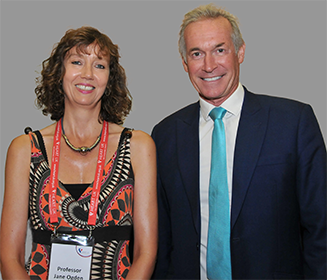The 31st HEART UK Annual Medical and Scientific Conference took place at the University of Warwick from 5th – 7th July 2017. This year’s conference focused on cholesterol management in the future and reflected the current period of change in health care delivery and expectation. Jaqui Walker reports the meeting’s highlights.
Genetic disease
The benefits of child-parent screening for familial hypercholesterolaemia (FH), were explored by Professor David Wald (Wolfson Institute of Preventive Medicine, Barts and The London School of Medicine and Dentistry, Queen Mary University of London). Detection rates are highest if FH is screened for in children between one to two years of age – a heel prick test, for example, is quick to carry out at routine immunisation appointments and uptake rates of 84% have been achieved. Screening is effective – a rate of four children and four parents are identified for every 1,000 children screened. The child benefits twice: their own FH is detected and the premature death of their parent is prevented.
This type of population screening is inexpensive when combined with routine immunisation and is helping to achieve the ultimate goal of identifying all or nearly all of those children with FH in the general population.
The signs, symptoms and management of inborn errors of lipoprotein metabolism in children was discussed by Dr Uma Ramaswami (Royal Free London NHS Foundation Trust). She explained how some children present over and over again with symptoms before being diagnosed. A lipid profile for children that present with non-specific abdominal pain to paediatric clinics should be considered. With the exception of heterozygous FH, these conditions are mostly rare, but they can cause significant morbidity and mortality. They require specialist input from paediatric dietitians and clinicians. Several therapies are emerging to treat these conditions and early diagnosis is important.
Professor Steve Humphries (University College London) explored polygenic FH and explained the low-density lipoprotein (LDL) cholesterol single nucleotide polymorphism (SNP) score to delegates. Overall, in FH, a monogenic molecular cause is found in only 35%–47% of patients. SNP scores can be used to help stratify the remaining patients. A score using the top six SNPs appeared to work best.
Once mutation in the LDLR/APOB/PCSK9 gene is ruled out, the most likely cause of the FH phenotype is a polygenic inheritance, and this type of FH would be better called polygenic hypercholesterolaemia. In fact, in subjects in the top three quartiles of a 6-SNP score, there is more than a 95% probability of a polygenic aetiology for their LDL cholesterol being over 4.9 mmol/L. Studies have shown the 6-SNP score discriminates well in European FH patients but data is needed in other ethnic groups. The number of patients that carry an unidentified FH-causing mutation is likely to be a very rare event.
Polygenic patients have been shown to have less severe disease, which means they could be more easily managed in general practice with a statin, for example. The focus of attention in tertiary centres should be on those with a monogenic cause who are more at risk and are likely to require the prescription of novel more expensive agents.
New therapies
Practical advice on the use of proprotein convertase subtilisin-kexin type 9 (PCSK9) inhibitors was shared by Professor Elizabeth Hughes (Sandwell General Hospital, West Bromwich). This new class of drugs are monoclonal antibodies, which have a powerful LDL-cholesterol lowering effect and recent outcome data showing a reduction in cardiovascular events in high-risk patients. The National Institute of Health and Care Excellence (NICE) has approved the use of these agents for high-risk patients including those with FH. With increasing numbers of people now using these drugs for life-long therapy, shared care pathways with primary care are important.
Processes to gain access to these agents vary between CCGs – secondary care may need time to fill out approval paperwork, for example, in addition to arranging education for the patient on how to self- administer the subcutaneous injection and confirming home delivery arrangements. A 12-week assessment of the drug efficacy in individual patients is often required and this needs to be factored into the patient pathway. Side effects are usually mild but should be reported using the yellow card system as these are new treatments. Should side effects occur, switching agents, reducing the dose, or missing one or two doses to identify whether the side effect is associated with the new therapy may help.
Helping patients achieve goals
Dr Tim Chadborn (Public Health England) explored the psychology behind decision-making processes and explained how using this psychology can help plan lifestyle interventions. Dr Chadborn showed the audience some successful examples, such as a social contract that could be signed and witnessed by someone other than the patient could significantly increase the ability of an intervention group sticking to their planned behavioural goals.
Our psychology is such that we feel loss twice as much as we feel gain. This can be applied to the design of interventions to change behaviour. In one study looking at weight loss, those in the intervention group paid $3 into an account each day and this was matched by the researcher resulting in $6 a day. This money was lost if the goal was not achieved. At the end of the study, the intervention group had lost 6.4 kg compared to a weight loss of 1.8 kg in the control group.
Loss aversion can be used to effectively structure financial incentives for goal adherence. Public Health England are developing and evaluating some apps to help behaviour change. Guidance is also available to help commissioners, clinicians and researchers use behavioural insights in the interventions they plan.
Lifestyle
Dr Stephen Lawrence (University of Warwick Medical School) discussed the current concern surrounding type 2 diabetes, which is highly prevalent and carries a 75% increased risk of dying from cardiovascular disease (CVD). He identified primary as being well placed to have an impact on this burden of CVD morbidity and mortality. Preventing diabetes occurring in the first place is vital and studies have shown that simple lifestyle changes can reduce the incidence of developing diabetes by up to 50% in those identified with impaired fasting glucose. In those with diabetes, taking a multifactorial interventional approach to controlling blood pressure, cholesterol, and Hba1c, lifestyle changes have been shown to translate into a 53% relative risk reduction in CVD and a 60% reduction in microvascular complications.

A historical overview of the research surrounding our understanding of the role of diet in cholesterol management was the subject of this year’s Myant Lecture, given by Professor Tom Sanders (King’s College London). He emphasised the importance of decreasing the intake of dietary trans and saturated fatty acids and maintaining a healthy weight. While death rates from CVD have declined substantially, the prevalence of obesity is increasing and having adverse effects on lipid metabolism.
Although, the effects of modification of dietary fat intake on blood cholesterol are modest, much greater effects are seen when the overall diet is changed particularly when a vegan diet is adopted. The Portfolio diet, which is a largely vegetarian diet with added plant sterols, nuts, soya and wholegrains, brings about substantial reduction in LDL-cholesterol but for many people it is difficult to follow. Current UK dietary guidelines have been shown to lower LDL-cholesterol by 10% and also decrease the risk of CVD by mechanisms such as lowering blood pressure.
Professor Jane Ogden (University of Surrey) led the audience through the evidence and reasons for food choice being largely a modifiable psychological factor rather than just a biological one. The scheme in our heads (which develops from our childhood and culture), as well as environmental triggers, act as the key drivers for weight gain and this differs from the current public perception of weight gain being something to do with biological factors, such as genetics, metabolism or gut hormones. Migration data and social network studies show body weight to be contagious. Research in Professor Ogden’s own department indicates the way food is presented, with factors such as what the food is called (e.g. snack versus meal), where and how it is eaten, all influencing the total number of calories we consume. Current habits of grabbing and eating food on the go encourage a higher overall consumption.
Professor Gary Frost (Imperial College London) described the “devastating change” in the UK and other wealthy countries on body weight and how this is a massive public health problem with no current solution. Three generations ago, in the 1900s when people were living in an era when malnutrition was rife, they benefitted from the body’s adaptive mechanisms that today make it hard to lose weight. For example, the brain has an ability to override a sensation of satiety and enable a person to eat pudding after a big meal. In the past, this ability to eat food to excess when it was available was important for survival.
In looking for solutions, Professor Frost described obesity as a chronic disease requiring structured clinical pathways with options and long-term support to manage it. He recommended the 2015 Scottish Intercollegiate Guideline Network (SIGN) Management of Obesity guidelines for useful pathways. Successful lifestyle interventions show that simple messages with frequent face-to-face contact for support help the most.
Although short-term weight loss is relatively easy, maintaining weight stability after this is more difficult. Managing hunger is an important issue and high protein, low glycaemic index (GI) diets can help. Professor Frost’s group are working on developing a functional fibre, which can manipulate anorectic peptides in the colon to reduce appetite, thus helping people use their natural body systems to manage their appetite. It is hoped that this inulin-propionate ester will be added to the food people normally eat, such as smoothies or bread. Although obesity is conceptually simple, it is a complex condition from both a physiological and behavioural point of view. Professor Frost believes government intervention will be required to exert influence over the food chain and to make a difference to the population’s health.

TV personality, Dr Hilary Jones (General Practitioner, Medical Broadcaster and Author) explained that whilst the media can create confusion and distress, with its sensational and conflicting attention-grabbing headlines, it also presents a useful opportunity. Trusted clinicians should get involved and ensure balanced accurate messages are put across to large audiences in an authoritative way with confidence, consensus and perspective. Dr Jones called for more healthcare professionals to get involved with the media to help educate the public. Researchers should be encouraged to work with colleagues to share important news before it breaks. Basic media training, such as handling difficult questions and having concise, pithy, rehearsed, statements for interviews is very useful.
Dr Jones recommends being proactive and using current technology to keep up-to-date with current news stories and the balance of opinion. There are apps that can be used for this and the NHS Choices website provides an unbiased, evidence-based analysis of news stories.

